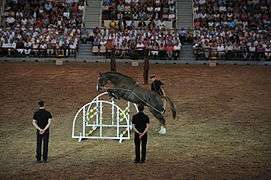Cadre Noir

The Cadre Noir (French: Cadre noir) is a corps of ecuyers, or instructors, at the French military riding academy École Nationale d'Équitation at Saumur in western France, founded in 1828. It also performs as an equestrian display team. Its name comes from the black uniforms that are still in use today. It is considered one of the most prestigious horsemanship schools in the world.
History
The historic role of the Saumur School of Cavalry was to provide training for the officers and non-commissioned officers of the French cavalry. The style of equitation characteristic of the school was first taught by François Robichon de La Guérinière, the French riding master to King Louis XV and author of the manual École de Cavalerie published in 1731. In 1843, François Baucher introduced his method into the school. This event marked the beginning of a small "war" between the vicomte d'Aure (head of the school) and Baucher, which continued for several years.
After World War II the mounted element of the French Army had been reduced to a few squadrons of spahis (disbanded in 1962) and the primarily ceremonial Cavalry of the Republican Guard. While the need for a purely military riding academy had almost vanished, the international prestige of French horsemanship ensured the survival of the Saumur training centre in the form of a national riding school under the Ministry of Sports.
Accordingly, in 1972, the National School of Équitation was constituted around the Cadre Noir, which provided its core teaching staff. Today, there are about 50 horses and a team of elite riders, usually limited to 22. The members of the Cadre Noir have either civilian or military status. Military and civilian riders are distinguished by the insignia on their collar: a grenade for the military or a sun for the civilians. Some of the riders have reached the highest level of international sport, being Olympic or world champions.
The Cadre Noir mainly uses Thoroughbreds, Anglo-Arabians, Hanoverians and Selle Français, but also keeps Lusitano horses to demonstrate the 16th and 17th century baroque style of riding. The Thoroughbreds and Anglo Arabians are used for the Grand Prix dressage, and perform individually, pas de deux (two horses), pas de trois (three horses), and dûe quantité (four or more horses). They may be either displayed in hand or ridden.
-

Olympic champion Didier Courrèges
-

Cadre Noir in gala uniform
-

Croupade
-

Cabriole
-
.jpg)
Jumping display over a single upright pole
-

Longeing demonstration over fences
-

The Grand manège des écuyers
The Selle Français are used to display the 'airs above the ground.'
Bibliography
- Jacques Perrier et Durand (dir.), L'Épopée du Cadre noir de Saumur, Lavauzelle, 1994, 110 p. (ISBN 2è7025-0331-4)
- Roger Gaborieau (ill. Alain Laurioux), Le Cadre noir de Saumur, École nationale d'équitation, 1996, 39 p.
- Patrice Franchet d'Espèrey, Le Cadre noir de Saumur, Paris, Arthaud, 1999, 159 p. (ISBN 2-7003-1211-2)
See also
- Spanish Riding School Vienna
- Royal Andalusian School of Equestrian Art (Jerez de la Frontera)
- Escola Portuguesa de Arte Equestre
External links
| Wikimedia Commons has media related to Cadre noir. |
- Official site of the French National Riding School and the Cadre Noir of Saumur
- Official site (French)